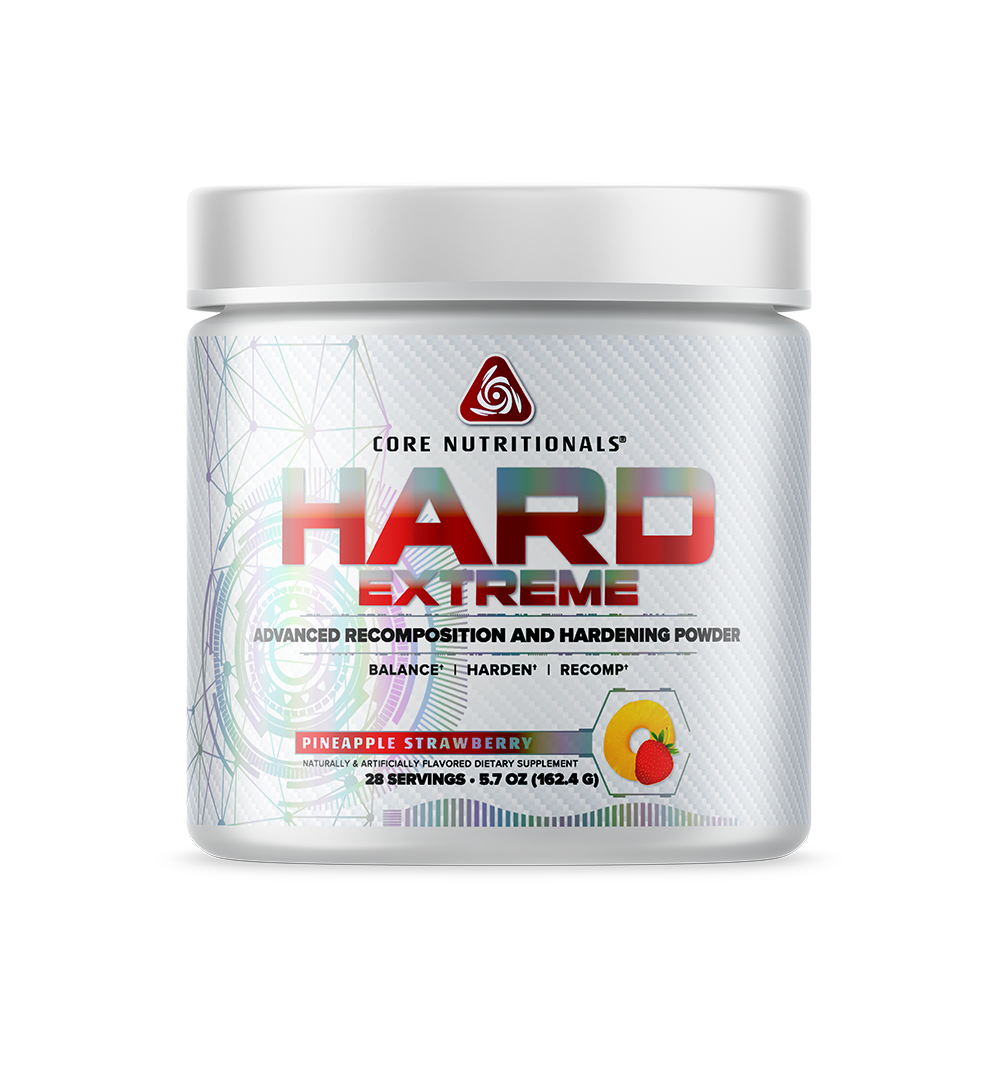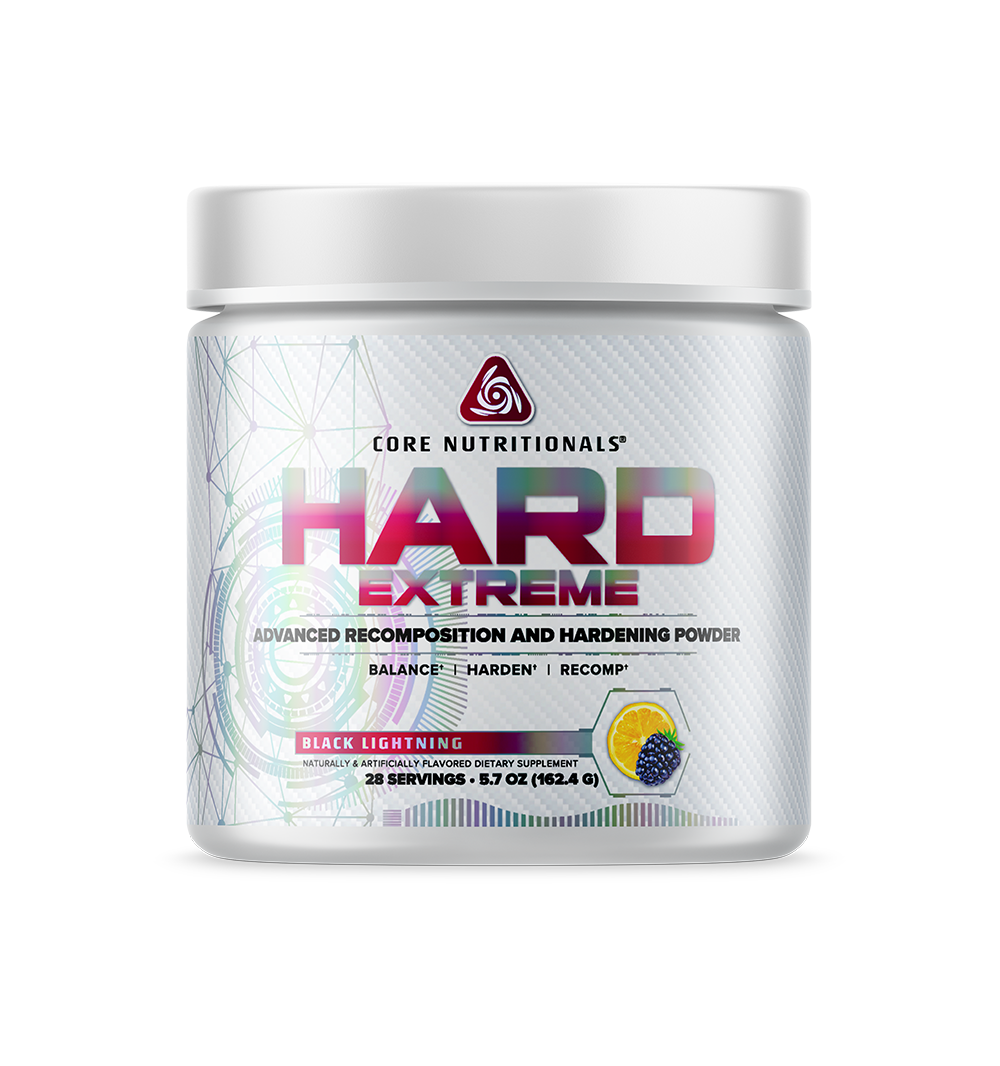


Recomposition Powder
-
To be hard, you need to get HARD. It's that simple.
Core HARD is the pinnacle in recomposition supplementation. The ingredients in HARD have been specifically chosen to balance your hormonal environment and maximize your lean mass.
- 3 scoops per serving.
- 28 servings per container.
- Body recomposition.
Your diet is impeccable and couldn’t be any more in check – macros, micros, you have it all down. Your workouts? Get out of here! You have slaved, grinded, and grunted your way through leg workouts so intense the gym staff cried – and those were on your worst days. And yet, something is missing.
It’s that “extra” level of shred, “that look.” You know exactly what we mean. That type of leanness and density that makes an arm look twice as big, a stomach look twice as lean, and a forearm look like a roadmap for the Italian countryside. It’s that kind of elusive hardness that’s so rare, most of us simply chalk it up to genetics, or luck, or steroids, or whatever excuse we have handy – and yet we all still want it.
The reality? It isn’t all that unattainable. Getting “that” look, “that” hardness, is about balance and recomposition. It’s a matter of adding in that final piece of the puzzle that makes the entire picture come out perfectly.
To be hard, you need to get HARD. It’s that simple.
Core HARD is another product in the Core Nutritionals’ lineup to follow the basic, but indispensable principles that Core Nutritionals is slowly making an industry standard: create products with effective ingredients, in effective doses, in a non-proprietary formula. This time around, we have applied those principles to the problem of softness that we all despise and have developed the most advanced ultra-hardening and recomposition agent on the market.
Taking advantage of both the old and the new, Core Nutritionals has employed both modern, cutting-edge compounds and traditional herbs to create a balanced approach to delivering hardness. Key ingredients in Core HARD affect some of the body’s critical physiological pathways, combining sexiness and science in a single, non-proprietary formula. We have included seven powerful ingredients into a full month's worth of stimulant free, recomposition goodness.
Physiological Properties and Effects:
KSM-66® Full-Spectrum Ashwagandha Extract (Withania somnifera) (root) (5% withanolides)
Withania somnifera Dunal, colloquially known as Winter Cherry or Indian Ginseng, is an herb that features prominently in the traditional Indian medicinal system of Ayurveda. Known as Ashwagandha in Ayurveda, Withania somnifera is a critical ingredient in various Ayurvedic tonics and tinctures prepared as a traditional remedy for the treatment of various ailments.
Recently identified as a potent adaptogenic and target for therapeutic applications, Ashwaghanda has been the subject of numerous animal, pre-clinical, and clinical trials designed to examine its potential effects as an antioxidant, anti-carcinogenic, anxiolytic, antibacterial, antifungal, and immonumodulating compound. Ashwaghanda’s broad therapeutic potential is hypothesized to be the result of its robust phytochemical profile, including a wide swath of alkaloids, sitoindosides, and the highly biologically active withanolide group. As the principally biologically active compounds within Ashwaghanda, withanolides such as withanone, withaferine A, withanolides A, D, and G have been identified, isolated, and extensively studied in the various applications noted above.
In recognition of the potential physiological benefits of withanolides, Core Nutritionals selected KSM-66® to include in its HARD formula. KSM-66® is a full-spectrum Ashwaghanda extract, standardized for 5% withanolides – meaning that KSM-66® not only includes the full range of biologically active compounds within Ashwaghanda, but also that it contains the highest currently available concentration of the principally active withanolides (5%).
The high concentrations of withanolides within KSM-66® has resulted in encouraging results in a number of human, clinical trials – particularly considering many of these trials were conducted using the methodological gold standard of randomization, double-blind delivery, and placebo control. Amongst the most impressive results contained in these trials:
- A 27.9% reduction in serum cortisol levels, measured over 60 days in a trial featuring 64 chronically stressed adults.
- Statistically significant increases to endurance and stamina, as measured by VO2 max, in a clinical trial featuring 50 healthy, exercise-trained adults.
- Increased measures of well-being as reported by self-assessment scales, included in both the clinical trials mentioned above.
- Statistically significant increases in serum testosterone levels in a clinical trial featuring 68 infertile men.
Though each of these results is impressive, perhaps the most significant is the 27.9% reduction in cortisol seen in the 60 day trial. As detailed above, cortisol possesses a multitude of potentially degradative physiological effects, including: inhibiting glucose uptake, causing a constriction of the vasculature (vasoconstriction), the breakdown of glycogen, and inarguably the result most would desire to avoid, proteolysis (the breakdown of muscle tissue).
Phosphatidylserine (50%)
Phosphatidylserine, colloquially known as PS, is a nearly ubiquitous phospholipid found in various membranous tissues throughout the body. PS’s ubiquity coincides with its necessity for crucial physiological functions, as the phospholipid is implicated in several components of cell communication, as well as the mediation of catecholamine synthesis and transmission in the brain (along with other neuroendocrine functions). In a fitness-related context, a nascent but growing body of methodologically-sound research suggests that PS may play a role in increasing exercise capacity.
Studies administering the compound in both acute and chronic fashion suggest that PS has a measurable effect on exercise capacity. In a double-blind, placebo-controlled, randomized trial involving 16 trained athletes, phosphatidylserine was administered for 10 days prior to an acute exercise challenge. Exercise markers such as exercise time to exhaustion, sprint performance, and ratings of perceived exertion, were measured post-exercise. The authors found that exercise time to exhaustion was significantly altered. Related studies using similar serving sizes have found that chronic PS administration increased shot accuracy in golfers, increased exercise time to exhaustion by 28% in cyclists, and reduced subjective feelings of stress and soreness in others.
Overall, phosphatidylserine appears to play a valuable role in the increase in exercise capacity. PS may therefore play a critical role in the continued exercise success of bodybuilders in a, “cutting” or recomposition stage.
Pomegranate Extract (Punica granatum) (hull) (ellagic acid 40%)
Pomegranate is a fruit-bearing deciduous shrub, endemic to and cultivated in wide swaths of both Europe and Asia. Pomegranate is also the predominant member of two species comprising the Punicaceae family
Pomegranate fruit has long been consumed as a dietary staple, and recent research has uncovered that the peel, in particular, harbors a broad range of physiologically active compounds known as polyphenols – most prominently ellagitannins. When consumed, these ellagitannins are hydrolyzed to ellagic acid in the gut, and released into the blood, allowing ellagic acid to be widely distributed to many target tissues and organs.
While still preliminary, emerging animal and in vitro data on PME (pomegranate extract) suggests that both specific and whole plant extracts may exert interesting endocrine effects. In a study examining the effects of PME on cultured human cells, PME was shown to down-regulate estrogen-receptor gene expression, and inhibit binding – suggesting that PME may possess some anti-estrogenic effects, at least in vitro. In another study in rats, PME’s robust antioxidant profile was hypothesized to increase androgenic activity via reducing oxygen radicals in the testes.
Though PME lacks robust human data, the available literature suggests that this compound may possess some highly useful physiological effects.
White Button Mushroom Extract (Agaricus blazei) (fruit) (30% polysaccharides)
Agaricus blazei, known commonly by a plethora of names – including button mushroom, white button mushroom, table mushroom, and champignon mushroom – is a small, edible mushroom endemic to North America and Europe. The most commonly consumed mushroom on the planet, commercial production and consumption of white button mushroom has existed since at least the early 18th century, while indigenous oral records suggest the plant was consumed for centuries prior.
Recent medical research has discovered that white button mushroom is a rich source of biologically-active compounds, including ergothioneine, an antioxidant with particularly potent free radical scavenging activity. Similar research has found that white button mushrooms – along with other varieties – possess unsaturated fatty acids such as linoleic acid, linolenic acid, and conjugated linoleic acid that may exert inhibitory activity on human aromatase, a cytochrome-P450 complex responsible for the conversion of testosterone into estrogen.
In two separate studies by similar researchers, both rats and human cell lines were fed and/or incubated with various extract strengths and doses of white button mushroom extract. Both the animal experiments and “in-cell” aromatase assays demonstrated that WBME exerted powerful anti-aromatase effects, reducing total aromatase amounts and activity across all experimental conditions.
The most encouraging aspect of these studies is the servings of white button mushroom used in the experimental conditions: they are easily achievable through oral consumption, unlike many other plant-based, physiologically active compounds.
L-Theanine
Though the literature surrounding L-theanine is still emerging, the amino acid is slowly building a reputation as one of the most interesting and exciting compounds being targeted for therapeutic use. L-theanine is an amino acid found almost exclusively in tea, constituting approximately 1-2% of the dry weight of tea – resulting in a 25–60 mg theanine load per 200 ml serving of liquid tea.
First identified in green tea and in the mushroom Xerocomus badius, L-theanine readily crosses the blood-brain barrier in a dose-dependent manner, and it is thought to influence the central nervous system (CNS) through a variety of mechanisms, including:
- Inhibiting glutamate reuptake and blockade of glutamate receptors in the hippocampus.
- Increasing gamma-aminobutyric acid (GABA – a neurotransmitter associated with the regulation of responses) concentrations.
In addition to these more well-demonstrated effects, emerging electroencephalography trials on theanine suggest that the amino acid may exert a positive effect on alpha waves – a type of brain wave implicated in restful relaxation. Alpha activity has also been associated with increased creativity, increased performance under stress, and improved learning and concentration, as well as decreased anxiety.
3,3'-Diindolylmethane (DIM)
What we typically refer to as “Estrogen,” is in fact a group of three biologically distinct hormones – estradiol (E2), estrone (E1), and estriol (E3), each possessing different activities in different cell, tissue, and receptor types. When experts refer to either the benefits or downfalls of “estrogen," they really mean to identify a specific estrogen.
These specific estrogens, in turn, metabolize into even more specific estrogen sub-compounds, such as the 2-hydroxyestrogens (2-OHE’s), 2-methoxyestrogens, 16a-hydroxyestrone (16-OHE1), and 4-hydroxyestrogens (4-OHE’s). As their parent estrogens, these estrogen metabolites exert different effects depending upon the tissue and cell one is examining. In fact, two estrogen metabolites in particular, 16-OHE1 and 2-OHE, have such contrasting cellular activities that 2-OHE is an estrogen antagonist. Yes, that is correct: there is an anti-estrogen, estrogen.
In recent years, so-called phytonutrients have become the focus of clinical research, as these natural compounds have shown the ability to modulate the body’s estrogen ratio. One of these phytonutrients, is a dietary indole known as indole-3-carbinol (I3C). Unfortunately, despite its metabolic usefulness, I3C is highly molecularly unstable, and therefore unsuitable for use as a therapeutic agent or dietary supplement.
Cocoabuterol®
Cocoabuterol®, made up of the bioactive compounds found in cocoa, has been shown through studies and application to have beneficial factors on fat loss, muscle building, and insulin sensitivity. This caffeine free ingredient exhibits a mechanism of action in the body to increase cAMP (cyclic adenosine monophosphate) levels, which acts as a second messenger and regulator of many movements exhibited by all three types of cells in the human body. In this context, fat (adipose) tissue epinephrine utilizes cAMP to increase to triglyceride hydrolysis and cardiac (heart) muscle epinephrine utilizes it to increase contraction rate. This action can have positive benefits on body composition and performance.
Theobromine, one of the main methylxanthine compounds found in cocoa is primarily effective in the increase of nitric oxide to in the blood stream, which is beneficial to produce the “pump” when ingested pre-workout. Another reaction that can be seen with theobromine is dilation of blood vessels. This can increase blood flow during vigorous exercise leading to increased time to exhaustion but also can pose benefits to individuals who suffer from high blood pressure. Theobromine also has a very high bioavailability and ability to stay in the body for extended periods of time (7-8 hours). Several studies have also looked at the effects of theobromine on human subjects and results have shown its ability to reduce oxidative stress on cells and regulation of gene expression.
Cocoabuterol® has also been shown to have positive benefits on reducing oxidative stress in the body. Due to its rich antioxidant properties, it has the ability to fight off free radicals that can be detrimental. In addition to this, the polyphenols that Cocoabuterol® contains have been shown to reduce inflammatory signals within the body that can also be detrimental biomarkers.
By now you have read some of the amazing benefits of Cocoabuterol® and why we have included in this recomposition agent. When your goal is maintaining muscle mass, shedding body fat, reducing overall stress, and performing at your peak, we make sure you are equipped with the right ingredients, in the right dosages, and for the right purpose. In summary, Cocoabuterol® does all of these things by:
- Increasing power output due to elevated NO production via theobromine effects.
- Increasing adipose usage through cAMP action in the body.
- Improving senses of well-being due to high levels of polyphenols and antioxidants reducing overall stress on the body from workouts and life events.
-






